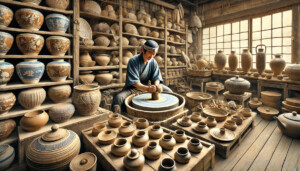Introduction
Japan is renowned for its rich cultural heritage and exquisite traditional crafts. Among these are the intricate lacquerware, the beautifully crafted pottery, and the delicate washi paper. These crafts are not only functional but also serve as a testament to the artistry and dedication of their creators. This article delves into the history and techniques of these traditional Japanese crafts, exploring their significance and the admiration they garner from overseas audiences.
Lacquerware: An Art of Layers
Lacquerware, known as “shikki” in Japanese, is one of Japan’s oldest and most revered crafts. The technique involves applying multiple layers of lacquer, derived from the sap of the lacquer tree, to a base material such as wood. This process can take months, as each layer must dry and harden before the next is applied.
The history of Japanese lacquerware dates back over 9,000 years, with evidence of lacquered objects found in the Jomon period. Over the centuries, the craft evolved, reaching its peak during the Edo period (1603-1868). During this time, artisans developed various techniques, such as “maki-e” (sprinkled picture), where gold or silver powder is sprinkled onto the wet lacquer to create intricate designs.
One of the most famous regions for lacquerware is Wajima, located in Ishikawa Prefecture. Wajima-nuri, the lacquerware from this area, is known for its durability and the meticulous process involved in its creation. Artisans use a mixture of lacquer and powdered clay to strengthen the base, followed by numerous layers of lacquer and decoration.
Pottery: Earth, Fire, and Tradition
Japanese pottery, or “yakimono,” encompasses a wide variety of styles and techniques, each region having its own distinct characteristics. The history of Japanese pottery is extensive, with some of the earliest examples dating back to the Jomon period (14,000-300 BCE).
One of the most renowned styles of Japanese pottery is “Raku,” which originated in the 16th century. Raku pottery is traditionally used in the Japanese tea ceremony and is known for its hand-molded, rustic appearance. The firing process is unique, involving removing the pottery from the kiln while still glowing hot and allowing it to cool in the open air, resulting in distinctive cracks and patterns.
Another significant style is “Imari,” which originates from the town of Arita in Saga Prefecture. Imari ware, known for its vibrant blue and white designs, became highly prized in Europe during the 17th century. The intricate patterns and fine craftsmanship of Imari pottery continue to be admired by collectors worldwide.
Washi Paper: The Art of the Hand
Washi, or traditional Japanese paper, is made from the fibers of the kozo (mulberry) plant, mitsumata shrub, or gampi tree. The process of making washi is labor-intensive, involving steaming, stripping, and beating the plant fibers before forming them into sheets.
The origins of washi date back to the Asuka period (538-710 CE), when papermaking techniques were introduced from China. Over time, Japanese artisans refined the process, creating paper that is strong, durable, and often translucent.
One of the most famous types of washi is “Echizen washi,” produced in Fukui Prefecture. Echizen washi has been made for over 1,500 years and is renowned for its high quality and versatility. It is used in various applications, from traditional calligraphy and printing to modern art and interior design.

Overseas Perspectives
From an overseas perspective, traditional Japanese crafts are often seen as embodying the essence of Japanese culture. The meticulous attention to detail, the reverence for natural materials, and the preservation of age-old techniques resonate deeply with international audiences.
Lacquerware, with its lustrous finish and intricate designs, is admired for its beauty and functionality. Overseas collectors and museums often seek out pieces of Wajima-nuri and other renowned styles, appreciating the skill and dedication involved in their creation.
Japanese pottery, particularly styles like Raku and Imari, is highly valued for its aesthetic appeal and historical significance. The unique firing techniques and the cultural context of tea ceremonies add an extra layer of interest for collectors and enthusiasts.
Washi paper, with its delicate texture and strength, is celebrated for its versatility and artistic potential. Artists and designers around the world incorporate washi into their works, recognizing its superior quality and the craftsmanship behind its production.
Interesting Anecdotes
- Lacquerware: In the 17th century, Japanese lacquerware became a coveted item in European courts. King Louis XIV of France was an avid collector, and many pieces of Japanese lacquerware were incorporated into the opulent interiors of the Palace of Versailles.
- Pottery: The Raku family, who pioneered Raku pottery, has a lineage that spans 15 generations. Each head of the family takes the title of “Kichizaemon,” continuing the tradition and passing down the unique techniques of Raku pottery.
- Washi Paper: The art of making washi was recognized by UNESCO as an Intangible Cultural Heritage of Humanity in 2014. This acknowledgment highlights the cultural significance and the dedication of the artisans who keep this tradition alive.
Conclusion
Traditional Japanese crafts such as lacquerware, pottery, and washi paper are more than just functional items; they are embodiments of Japan’s rich cultural heritage and the skill of its artisans. These crafts continue to captivate audiences worldwide, bridging cultures and showcasing the timeless beauty of Japanese craftsmanship.
By preserving and promoting these traditional crafts, we not only honor the legacy of the past but also inspire future generations to appreciate and continue these remarkable traditions. Whether admired in a museum, used in a tea ceremony, or incorporated into modern design, these crafts remain a testament to the enduring artistry of Japan.
Comment